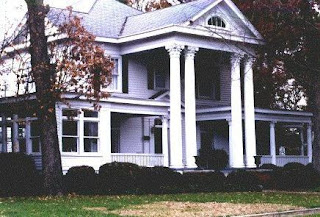"The above is a country home of Union county, situated six miles west of town; the owner is Mr. T.J. Gordon. He began life fifteen years ago on twenty acres of land received from his father's estate. He now owns twelve hundred acres, runs fifteen plows, and lives in comfort in the fine home pictured above. He has farmed exclusively, and his success shows what may be done on a Union county farm with brains and energy. He grows cotton, corn, grain and peas, and pays attention to clover. He is public spirited, and a leader in anything beneficial to his community." (Stack and Beasley, Sketches of Monroe and Union County)
T.J. Gordon was also vice president of the Union County Farmers Mutual Fire Insurance Company, incorporated in 1903.
Thomas Jackson Gordon was born 28 Sept 1862 in Union County to Lewis K. Gordon (1808-1883) and Obedience Layton Bass (1819-1884). Thomas married Mittie Presson (1861-1955) in 1894.
Thomas' father Lewis Gordon was first married Lucinda Osborne (1813-1847) about 1837 in then Mecklenburg County. Their children were: Millie Jane (1838-1913), Rachel (1841-1929), Mary Polly (1844-1913)and Lucretia Lucinda born 1847.
Lewis' second 1849 marriage was in Union County, to Obedience Beady Layton Bass. They had the following children including Thomas Jackson: Jonathan (1849-1860), Richard Harvey (1852-1927), Tabatha Adaline (1860-1934), Alice (1861-1934), Robert Lee (1864-1945) and William E. born 1865.
The 1870 Monroe Census recorded Thomas Jackson Gordon, age 9, with his parents and many siblings: Lewis 60, Beedy 50, Jane 30, Rachel 28, Mary 26, Martha 19, Richard 18, Josiah 14, John 13, Adeina 12, Alice 11, Robert 8 and 5-year-old William.
The 1880 Monroe Census recorded: farmer Lewis H. 72, wife Bedie 60, Millie J. 41, Rachel 39, Pollie A. 36, Josiah 23, Adeline 20, Alice 18, Thomas J. 17, Robt. Lee 16 and 13-year-old William E. Gordon.
The 1900 Monroe Census recorded: Thomas J. 37, Mittie 30, Craven 5, Mary 3, Willie 1, boarder John Griffin 25 and boarder George Griffin 19.
The 1910 South Monroe Census recorded: Thomas J. 47, wife Mittie 39, Craven N. 15, Mary 14, Willie 11 and 7-year-old Christine.
Thomas Jackson Gordon's death certificate noted cause of death was suicide by hanging, 27 Aug 1918.



 John William Rudge (1849-1915) was born in Le Havre, Seine-Maritime,
Haute-Normandie, France. In 1870, he married Caroline Virginia "Carrie"
Pae, who was born in Richmond. First settled in
Wilmington, they arrived in Monroe before 1876. 1880 Monroe census: tin
smith "tinner" John W. Rudge 31, milliner Carrie V. 31, daughter Carrie
V. 5, son Wm. John 4, daughter Kate 1, mother-in-law Sophia Pae 58 and
servant Robert Blair 35. More on the family at: W.J. Rudge Company.
John William Rudge (1849-1915) was born in Le Havre, Seine-Maritime,
Haute-Normandie, France. In 1870, he married Caroline Virginia "Carrie"
Pae, who was born in Richmond. First settled in
Wilmington, they arrived in Monroe before 1876. 1880 Monroe census: tin
smith "tinner" John W. Rudge 31, milliner Carrie V. 31, daughter Carrie
V. 5, son Wm. John 4, daughter Kate 1, mother-in-law Sophia Pae 58 and
servant Robert Blair 35. More on the family at: W.J. Rudge Company. 












 Of the Monroe Opera House, J. Ray Shute related the following in an interview,
Of the Monroe Opera House, J. Ray Shute related the following in an interview, "They came to Charlotte, but they didn't come to
Monroe. But we did have Weber and Fields, who afterwards became national
comedians. They were here in Monroe. And Thomas Dixon's "Klansman" was
shown here with a horse on the stage. That fascinated all of us. He came
out and talked during intermission. He was a young writer back then.
But it was pleasant. I enjoyed it."
"They came to Charlotte, but they didn't come to
Monroe. But we did have Weber and Fields, who afterwards became national
comedians. They were here in Monroe. And Thomas Dixon's "Klansman" was
shown here with a horse on the stage. That fascinated all of us. He came
out and talked during intermission. He was a young writer back then.
But it was pleasant. I enjoyed it."

